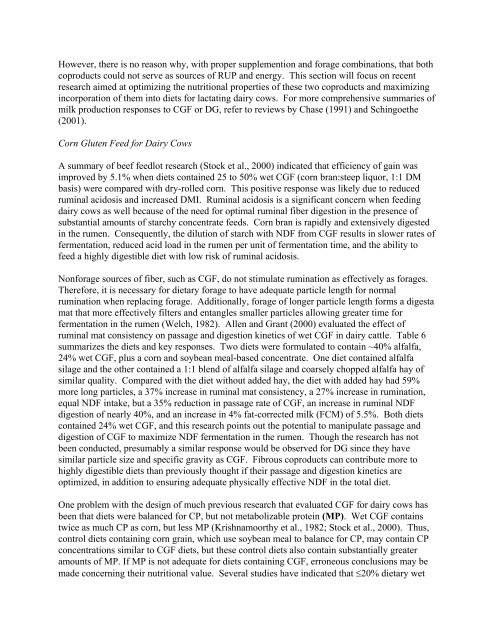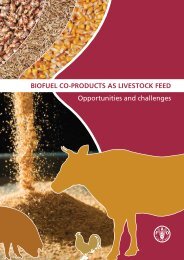Distillers Grains Feeding Recommendations. - Distillers Grains By ...
Distillers Grains Feeding Recommendations. - Distillers Grains By ...
Distillers Grains Feeding Recommendations. - Distillers Grains By ...
You also want an ePaper? Increase the reach of your titles
YUMPU automatically turns print PDFs into web optimized ePapers that Google loves.
However, there is no reason why, with proper supplemention and forage combinations, that bothcoproducts could not serve as sources of RUP and energy. This section will focus on recentresearch aimed at optimizing the nutritional properties of these two coproducts and maximizingincorporation of them into diets for lactating dairy cows. For more comprehensive summaries ofmilk production responses to CGF or DG, refer to reviews by Chase (1991) and Schingoethe(2001).Corn Gluten Feed for Dairy CowsA summary of beef feedlot research (Stock et al., 2000) indicated that efficiency of gain wasimproved by 5.1% when diets contained 25 to 50% wet CGF (corn bran:steep liquor, 1:1 DMbasis) were compared with dry-rolled corn. This positive response was likely due to reducedruminal acidosis and increased DMI. Ruminal acidosis is a significant concern when feedingdairy cows as well because of the need for optimal ruminal fiber digestion in the presence ofsubstantial amounts of starchy concentrate feeds. Corn bran is rapidly and extensively digestedin the rumen. Consequently, the dilution of starch with NDF from CGF results in slower rates offermentation, reduced acid load in the rumen per unit of fermentation time, and the ability tofeed a highly digestible diet with low risk of ruminal acidosis.Nonforage sources of fiber, such as CGF, do not stimulate rumination as effectively as forages.Therefore, it is necessary for dietary forage to have adequate particle length for normalrumination when replacing forage. Additionally, forage of longer particle length forms a digestamat that more effectively filters and entangles smaller particles allowing greater time forfermentation in the rumen (Welch, 1982). Allen and Grant (2000) evaluated the effect ofruminal mat consistency on passage and digestion kinetics of wet CGF in dairy cattle. Table 6summarizes the diets and key responses. Two diets were formulated to contain ~40% alfalfa,24% wet CGF, plus a corn and soybean meal-based concentrate. One diet contained alfalfasilage and the other contained a 1:1 blend of alfalfa silage and coarsely chopped alfalfa hay ofsimilar quality. Compared with the diet without added hay, the diet with added hay had 59%more long particles, a 37% increase in ruminal mat consistency, a 27% increase in rumination,equal NDF intake, but a 35% reduction in passage rate of CGF, an increase in ruminal NDFdigestion of nearly 40%, and an increase in 4% fat-corrected milk (FCM) of 5.5%. Both dietscontained 24% wet CGF, and this research points out the potential to manipulate passage anddigestion of CGF to maximize NDF fermentation in the rumen. Though the research has notbeen conducted, presumably a similar response would be observed for DG since they havesimilar particle size and specific gravity as CGF. Fibrous coproducts can contribute more tohighly digestible diets than previously thought if their passage and digestion kinetics areoptimized, in addition to ensuring adequate physically effective NDF in the total diet.One problem with the design of much previous research that evaluated CGF for dairy cows hasbeen that diets were balanced for CP, but not metabolizable protein (MP). Wet CGF containstwice as much CP as corn, but less MP (Krishnamoorthy et al., 1982; Stock et al., 2000). Thus,control diets containing corn grain, which use soybean meal to balance for CP, may contain CPconcentrations similar to CGF diets, but these control diets also contain substantially greateramounts of MP. If MP is not adequate for diets containing CGF, erroneous conclusions may bemade concerning their nutritional value. Several studies have indicated that ≤20% dietary wet
















